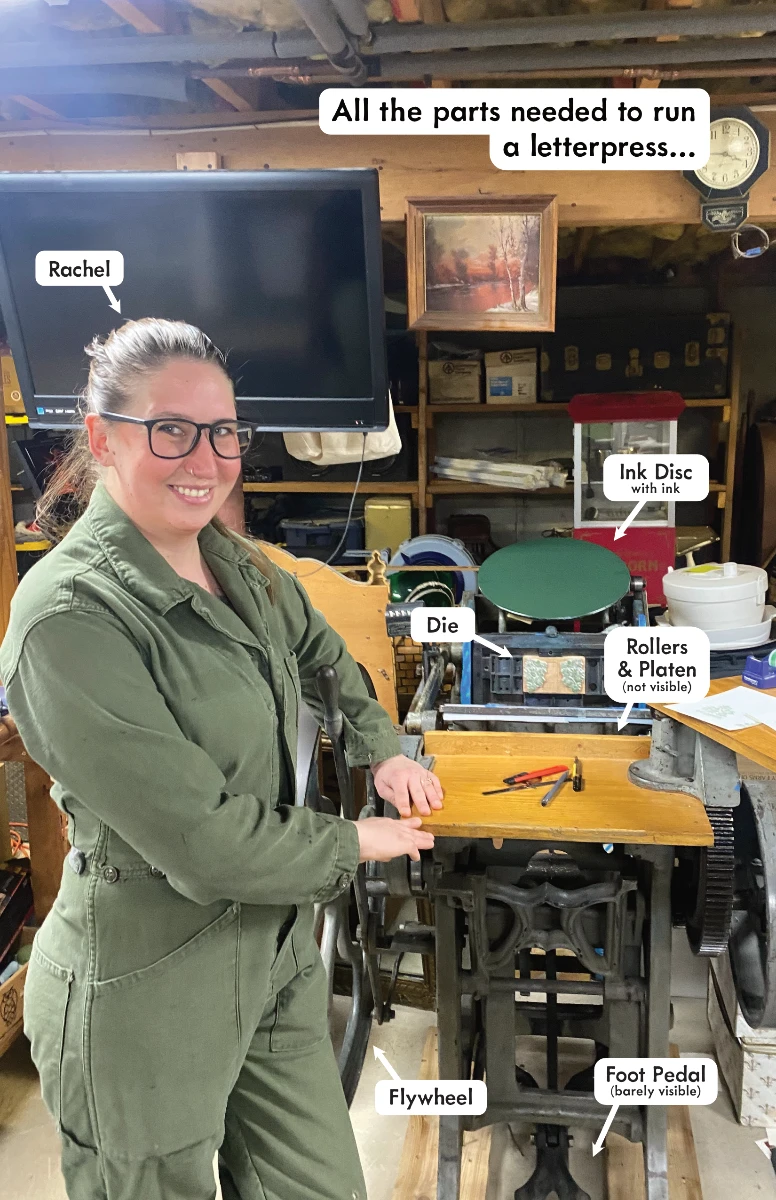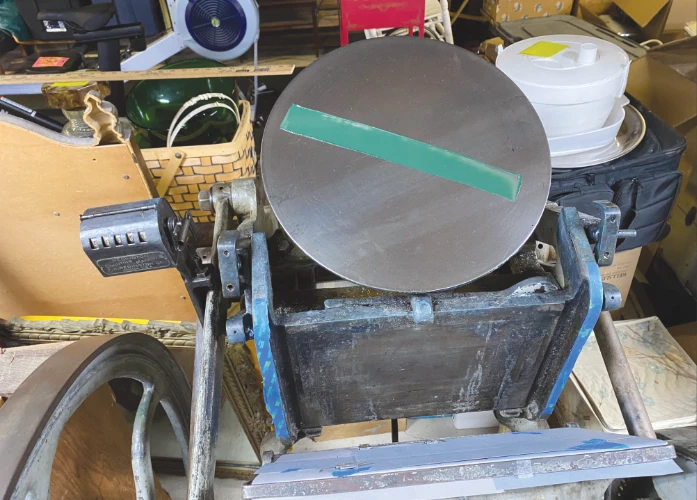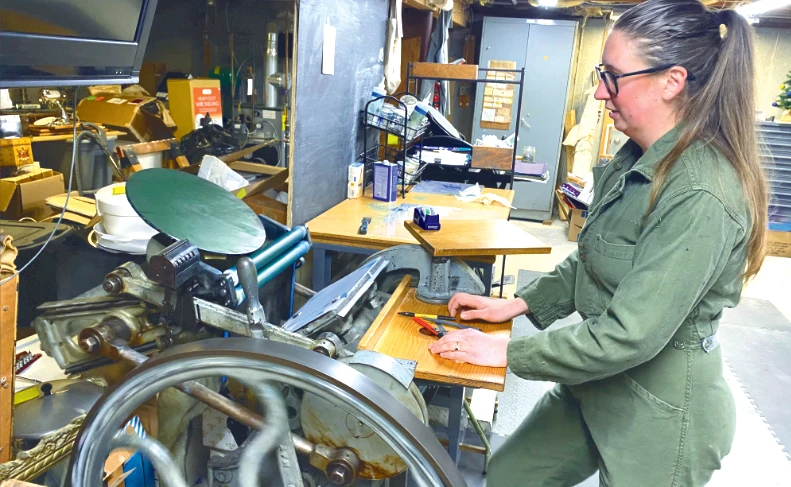
It’s possible that Rachel Herring is in possession of the only two working Gordon-style letterpress machines on Long Island. While these were common printing presses from the late 19th to mid 20th centuries, offset printing eclipsed letterpress printers by the 1950s. Chandler & Price, the major manufacturer of the Gordon-style machines, stopped making their presses in the mid 1960s. These machines are behemoths in their own right, with Rachel’s larger machine, probably built in the early 1910s, weighing in excess of 1,000 pounds. However, they’re smaller than offset printers and her letterpress machines work on manpower (Rachel-power?), not electricity.
So how do Rachel’s letterpress machines work? It all starts with spreading the ink out on a metal disc — no, wait, go back. It starts with a design. Rachel works with her customers to design a vector image which gets transferred to a metal plate, called a die, made from magnesium. This plate is a relief, where deeper impressions that will be made on the paper are raised on the die. Then Rachel mixes the ink for the print. “I mix all of the ink by hand. I can basically match anything that anybody wants. A fine art background [in painting] definitely helps with that,” she says.
 Now, she spreads out the ink on the disc, first by placing a smear of ink on a metal disc, then turning a large flywheel that moves rollers and turns the disc, until the entire surface of the disc is covered in ink. It seems like an impossibly thin coat, but that prevents the ink from pooling or spreading when transferred onto the paper. She secures the die under the inked disc and rollers. The rollers transfer ink from the disc onto the die, which then gets pressed into a platen that holds the paper.
Now, she spreads out the ink on the disc, first by placing a smear of ink on a metal disc, then turning a large flywheel that moves rollers and turns the disc, until the entire surface of the disc is covered in ink. It seems like an impossibly thin coat, but that prevents the ink from pooling or spreading when transferred onto the paper. She secures the die under the inked disc and rollers. The rollers transfer ink from the disc onto the die, which then gets pressed into a platen that holds the paper.
 The paper, cut by a large guillotine paper cutter affectionately nicknamed “Marie,” has a bit of thickness to hold the impression made by the die, which has transferred the ink into the impression at the same time. This entire operation gets powered by Rachel spinning the flywheel on the left side of the machine. She’s also pressing with her foot on a pedal that moves the platen towards the die. And then she skillfully puts each individual piece of paper on the platen on each backswing. It’s quite the workout, but Rachel gets into the rhythm and the process runs smoothly. Her experience and expertise is obvious watching her work the letterpress.
The paper, cut by a large guillotine paper cutter affectionately nicknamed “Marie,” has a bit of thickness to hold the impression made by the die, which has transferred the ink into the impression at the same time. This entire operation gets powered by Rachel spinning the flywheel on the left side of the machine. She’s also pressing with her foot on a pedal that moves the platen towards the die. And then she skillfully puts each individual piece of paper on the platen on each backswing. It’s quite the workout, but Rachel gets into the rhythm and the process runs smoothly. Her experience and expertise is obvious watching her work the letterpress.
After graduating from the Art Institute of Boston (now Lesley University College of Art & Design) and receiving the Boston Printmakers award, Rachel worked at Goosefish Press, which used a letterpress to print wedding invitations, personal stationery, greeting cards, and coasters. Rachel says Robert Charlton, the owner of Goosefish Press and her mentor, taught her everything she knows about letterpress printing. Moving back to Long Island in 2018 with a smaller letterpress machine (smaller is relative), Rachel started her business, but when Robert stopped using the letterpress that Rachel operated when she worked up in Boston, he offered it to her… if she could move it down to Long Island.
During a Nor’easter, Rachel and her husband drove the half-ton machine down to Miller Place, where it was moved into her basement studio. That’s dedication. And really, the complicated process of printing is smooth under her aegis because of her dedication to the craft. There’s the artistic aspect of the design phase, sure, but there’s an art to the printing, from mixing the ink, to selecting the paper and appreciating how its texture will hold the imprint and ink, to the rhythmic churn of the press as run by Rachel.
You can learn more about Rachel’s company, Blue House Press, at bluehousepress.com and visit her store at etsy.com/shop/bluehousepress, where she sells envelopes, coasters, postcards, greeting cards, and more, all printed from her letterpress. There is also a card rack of her work at Crazy Beans in Miller Place. And if you find her at a local art fair, you may be able to purchase what is our singular favorite coaster, which says, “Don’t fuck up the table. Please” with a small skull and crossbones.
